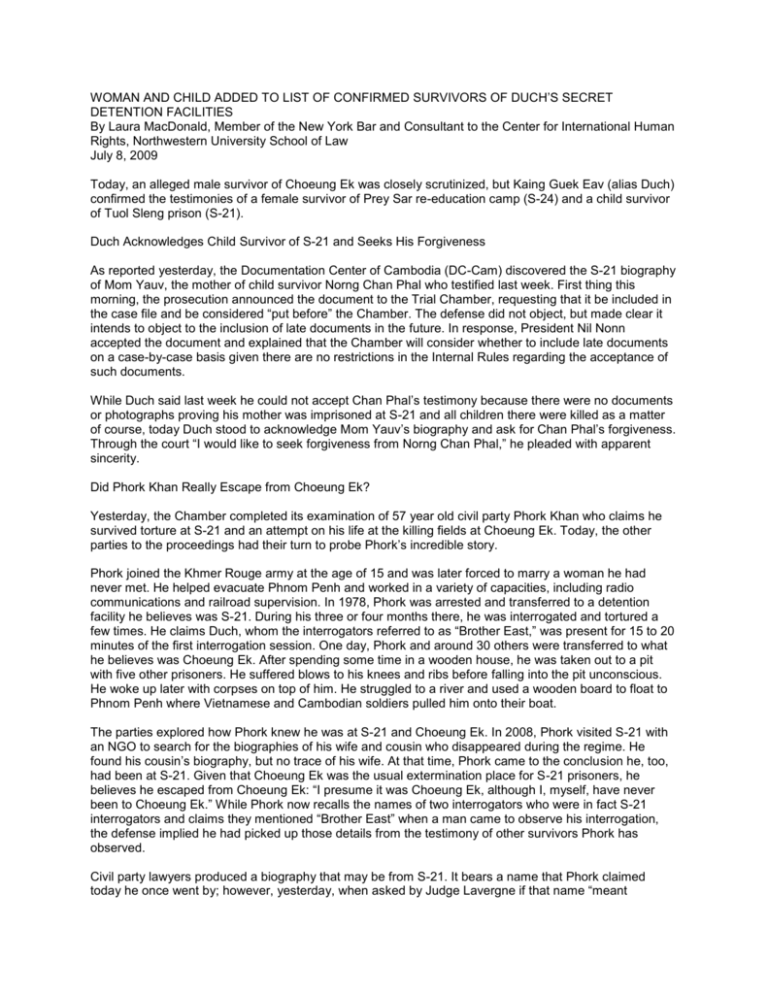woman and child added to list of confirmed
advertisement

WOMAN AND CHILD ADDED TO LIST OF CONFIRMED SURVIVORS OF DUCH’S SECRET DETENTION FACILITIES By Laura MacDonald, Member of the New York Bar and Consultant to the Center for International Human Rights, Northwestern University School of Law July 8, 2009 Today, an alleged male survivor of Choeung Ek was closely scrutinized, but Kaing Guek Eav (alias Duch) confirmed the testimonies of a female survivor of Prey Sar re-education camp (S-24) and a child survivor of Tuol Sleng prison (S-21). Duch Acknowledges Child Survivor of S-21 and Seeks His Forgiveness As reported yesterday, the Documentation Center of Cambodia (DC-Cam) discovered the S-21 biography of Mom Yauv, the mother of child survivor Norng Chan Phal who testified last week. First thing this morning, the prosecution announced the document to the Trial Chamber, requesting that it be included in the case file and be considered “put before” the Chamber. The defense did not object, but made clear it intends to object to the inclusion of late documents in the future. In response, President Nil Nonn accepted the document and explained that the Chamber will consider whether to include late documents on a case-by-case basis given there are no restrictions in the Internal Rules regarding the acceptance of such documents. While Duch said last week he could not accept Chan Phal’s testimony because there were no documents or photographs proving his mother was imprisoned at S-21 and all children there were killed as a matter of course, today Duch stood to acknowledge Mom Yauv’s biography and ask for Chan Phal’s forgiveness. Through the court “I would like to seek forgiveness from Norng Chan Phal,” he pleaded with apparent sincerity. Did Phork Khan Really Escape from Choeung Ek? Yesterday, the Chamber completed its examination of 57 year old civil party Phork Khan who claims he survived torture at S-21 and an attempt on his life at the killing fields at Choeung Ek. Today, the other parties to the proceedings had their turn to probe Phork’s incredible story. Phork joined the Khmer Rouge army at the age of 15 and was later forced to marry a woman he had never met. He helped evacuate Phnom Penh and worked in a variety of capacities, including radio communications and railroad supervision. In 1978, Phork was arrested and transferred to a detention facility he believes was S-21. During his three or four months there, he was interrogated and tortured a few times. He claims Duch, whom the interrogators referred to as “Brother East,” was present for 15 to 20 minutes of the first interrogation session. One day, Phork and around 30 others were transferred to what he believes was Choeung Ek. After spending some time in a wooden house, he was taken out to a pit with five other prisoners. He suffered blows to his knees and ribs before falling into the pit unconscious. He woke up later with corpses on top of him. He struggled to a river and used a wooden board to float to Phnom Penh where Vietnamese and Cambodian soldiers pulled him onto their boat. The parties explored how Phork knew he was at S-21 and Choeung Ek. In 2008, Phork visited S-21 with an NGO to search for the biographies of his wife and cousin who disappeared during the regime. He found his cousin’s biography, but no trace of his wife. At that time, Phork came to the conclusion he, too, had been at S-21. Given that Choeung Ek was the usual extermination place for S-21 prisoners, he believes he escaped from Choeung Ek: “I presume it was Choeung Ek, although I, myself, have never been to Choeung Ek.” While Phork now recalls the names of two interrogators who were in fact S-21 interrogators and claims they mentioned “Brother East” when a man came to observe his interrogation, the defense implied he had picked up those details from the testimony of other survivors Phork has observed. Civil party lawyers produced a biography that may be from S-21. It bears a name that Phork claimed today he once went by; however, yesterday, when asked by Judge Lavergne if that name “meant anything to him,” he clearly stated it did not. Yesterday, he further stated that although he knew of people mentioned in the biography, the information in the document was not about him. Today, Phork still maintained the biography did not provide information about him, although it did bear his former name. When pressed regarding his inconsistent statements, he explained that he must have misunderstood the questions yesterday. Duch acknowledged that Phork’s cousin was detained and smashed at S-21 given documents attesting to those facts, but claims no knowledge of Phork or his wife being detained at S-21. Again today, Phork was forced to explain why his oral testimony differs so greatly from the written statement that accompanied his civil party application. He explained that he met with the Cambodian Human Rights and Development Association (ADHOC), a non-profit organization, during a village gathering and a representative made a record of his story. The written record was sent to him through another organization for his thumbprint. At the time, he scanned the document, but did not read it carefully because he was told the document needed to be returned urgently. The written statement, for example, describes Duch interrogating Phork, threatening to kill him and his wife, and forcing him to drink water until he passed out. Whereas in court, Phork testified he never got a good look at Duch who simply sat in a chair and watched his interrogation. Phork acknowledged that there are mistakes in the written statement and apologized to the court. Woman Survived Duch’s Slave Labor Camp Late this morning, 51 year old civil party Chim Meth was called to the stand. She seeks justice for herself and five colleagues from her Khmer Rouge military unit, whom she only knew by first name. In response to the Chamber’s questions, Chim provided an extremely detailed account of her experiences during the Khmer Rouge period. She served in a female military unit performing a variety of functions, ranging from carrying wounded soldiers off the battlefield to raising pigs. In 1977, many members of her unit started to disappear and Chim’s superiors put together a biography on her. On November 10, 1977, she was arrested and sent to a detention facility that she believes was S-21. She was detained in a cell with two other women from her unit. After a few days, she was interrogated and tortured. After 15 days and nights there, Chim and the other two women were transferred to S-24 and put to work immediately. The conditions at S-24 were “miserable” prompting the women to discuss whether they should kill themselves. They were all weak and skinny with rashes and wounds of various types. The women were woken up around 2:30 a.m. to go out to the rice fields, sometimes hours from their shelter. With little food or water, they had to work until they met their quota for the day, whether they were digging canals or harvesting rice. The women were beaten when they complained or if they fell ill. People sometimes died at S-24, but more often they simply disappeared. One day, Chim was so weak she could not carry the loads required of her. After fainting a few times and being beaten, she was dragged to a different unit by two men. There, she grew vegetables and experienced better treatment, including a better food ration. She remained there until she heard the gunfire of the invading Vietnamese, at which point all the women in the unit fled. After months of hiding and running, she was taken in by an elderly woman in a small village where she took up a normal life as a farmer. Chim had heard of the Tuol Sleng Museum but never wanted to visit. However, a relative visited, saw a picture of Chim there, and told DC-Cam that she was alive and well. DC-Cam then contacted Chim to investigate her story. The Chamber put a black and white photograph of a woman up on the screen and Chim confirmed it was her at age 19. This same photograph was attached to a biography the Chamber put up on the screen. Duch confirmed that the photograph and document were from S-24, following the format used by his deputy. Given that Chim could not state for certain that she was detained at S-21 before being put to work at S-24, the President asked Duch to comment. Duch concluded that Chim was not detained at S-21. Rather, she was detained at a facility within her military division before being sent to S-24. If she were transferred directly to S-21, she would be dead, he reasoned. People sent from the divisions to S-21 were all smashed. Chim’s testimony was cut short, so she will return tomorrow for further questioning. Chamber Cracks Down on “Disorderly Behavior” Before one of the breaks today, the President said the Chamber has noticed that people have been entering and exiting the public gallery while the proceedings are underway. He instructed ECCC personnel “not [to] allow this disorderly behavior to continue” and asked them to make things run more smoothly. Since survivor testimony commenced last Monday, the public gallery has been packed everyday with nearly 600 people. Last week alone, 2078 people observed the proceedings as ECCC Public Affairs brought in busloads of villagers from nearby provinces. While public participation is obviously an amazing aspect of the proceedings, the facility is being pushed to its limits. With only one metal detector and one bag inspector, getting everyone in and out of the gallery during the 15-minute breaks is nearly impossible, not to mention getting everyone through the bathroom line. During the Public Affairs’ press conference today, a spokesman made light of the President’s remarks and noted that the court is for the Cambodian people. In other comments, Public Affairs urged the media to have patience with the civil parties and witnesses testifying given the trauma they experienced and the general lack of psychiatric assistance available during the last thirty years in Cambodia. A spokesman explained that the ECCC is the first international tribunal, other than the International Criminal Court, to allow for so much victim participation and the Chamber is learning and adapting as it goes along. If all goes according to schedule, by August 26, 2009, 13 witnesses and 22 civil parties will have testified in the Duch trial.







